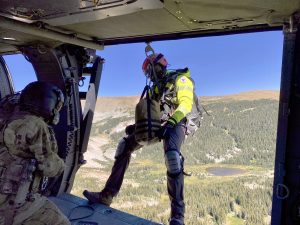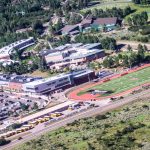Helicopter hoist rescues have continued at ‘crazy pace’ in Colorado this summer
Civilian search and rescue volunteers are swinging in on a pencil-thin cable attached to military helicopters to perform high-stakes rescues on Colorado 14ers and other high peaks
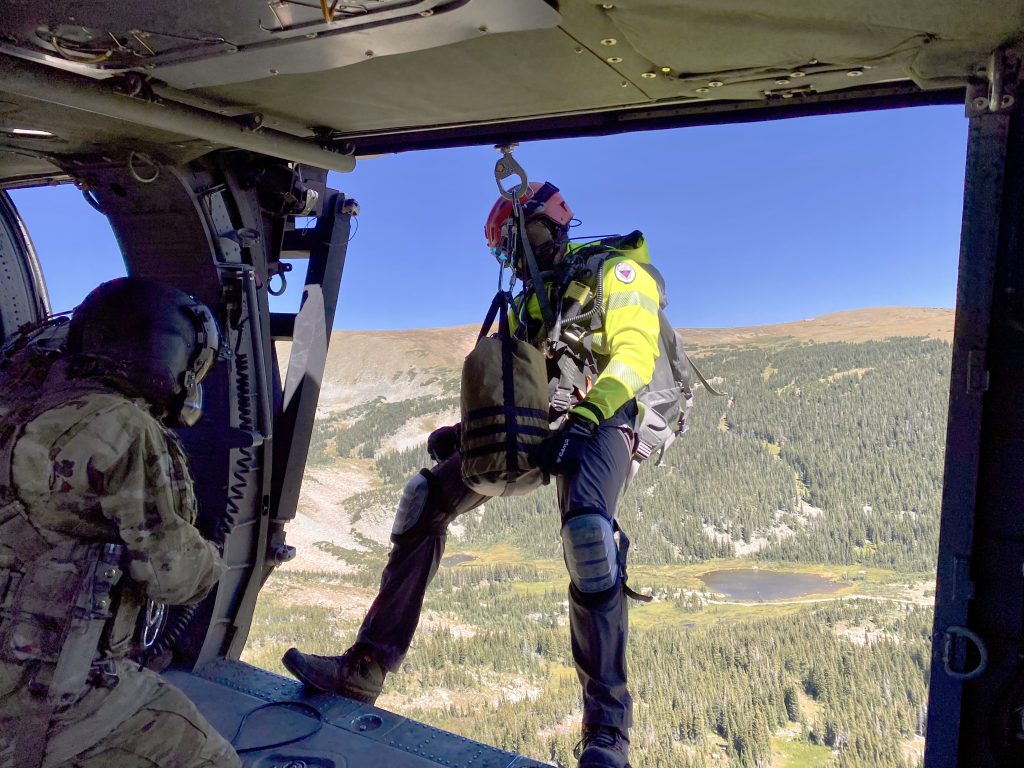
Alpine Rescue Team/Courtesy photo
The Colorado Hoist Rescue Team has been busier than ever this summer assisting with serious backcountry rescue missions where life or limb are on the line.
The team pairs military helicopters and flight crews with volunteers from civilian search and rescue teams to perform high-stakes hoist rescues in the state’s rugged, high-elevation terrain.
“Compared to previous years, our trend line is significantly above-average,” said Chief Warrant Officer Clayton Horney, who is the program manager of the Colorado Hoist Rescue Team for the U.S. Army.
Founded in 2016, the Colorado Hoist Rescue Team is a collaboration between the Colorado Army National Guard, the Colorado Search and Rescue Association and rescue teams from four counties.
So far this season, local sheriff’s offices have made 31 requests for helicopter hoists, compared to just 19 requests this time last year and 16 this time in 2023, Colorado Search and Rescue Association Public Information Officer Anna DeBattiste said on Monday.
But a helicopter hoist isn’t performed every time a hoist is requested, DeBattiste said. The Colorado Army National Guard has to first decide if a helicopter is warranted and whether the conditions are right to fly it. Sometimes, a hoist helicopter is asked to stand down after a request because a rescue mission resolves before it can get there.
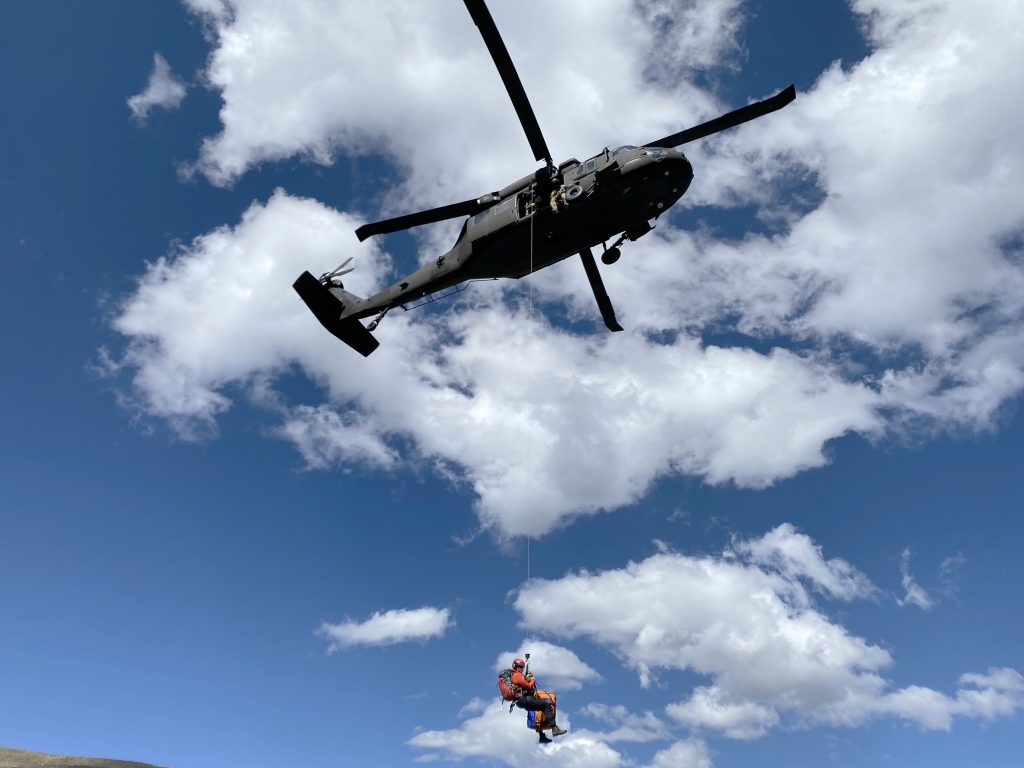
Of the 31 requests for helicopter hoists this year, the team has performed 18 hoists, which she said is thought to be more than ever for this point in the season.
“We continue to do hoists at a crazy pace,” DeBattiste said, noting that helicopter hoists are only used in the most extreme circumstances, when someone’s life, limbs or eyesight are threatened or when a ground rescue would be too dangerous for rescuers.
Over the past decade, the Hoist Rescue Team helped streamline approval processes and innovated cutting-edge dynamic hoist techniques to better respond to the growing number of calls for help from the backcountry, Horney said. But the military helicopters also have other priorities — including responding to wildfires — and aren’t a resource dedicated solely for backcountry rescue missions, he added.
The helicopters are expensive tools that require significant upkeep and flying them — especially at high elevations, where small differences in temperature and air density can have a big impact in a pilot’s calculations — involves significant risks, Horney said. So, he said only the Colorado Army National Guard decides whether a hoist helicopter response is warranted.
“Backcountry usage continues to increase, so ground teams are responding more, sheriffs are responding more,” Horney said. “So we’re in a fine balance. We understand the demand is more. We understand the expectations that may be out there from the public’s point of view. If something happens to somebody, we absolutely want to answer the call. But, in reality, as we trend up in the number of responses, we have to be careful not to eventually be using too many resources.”
A busy summer
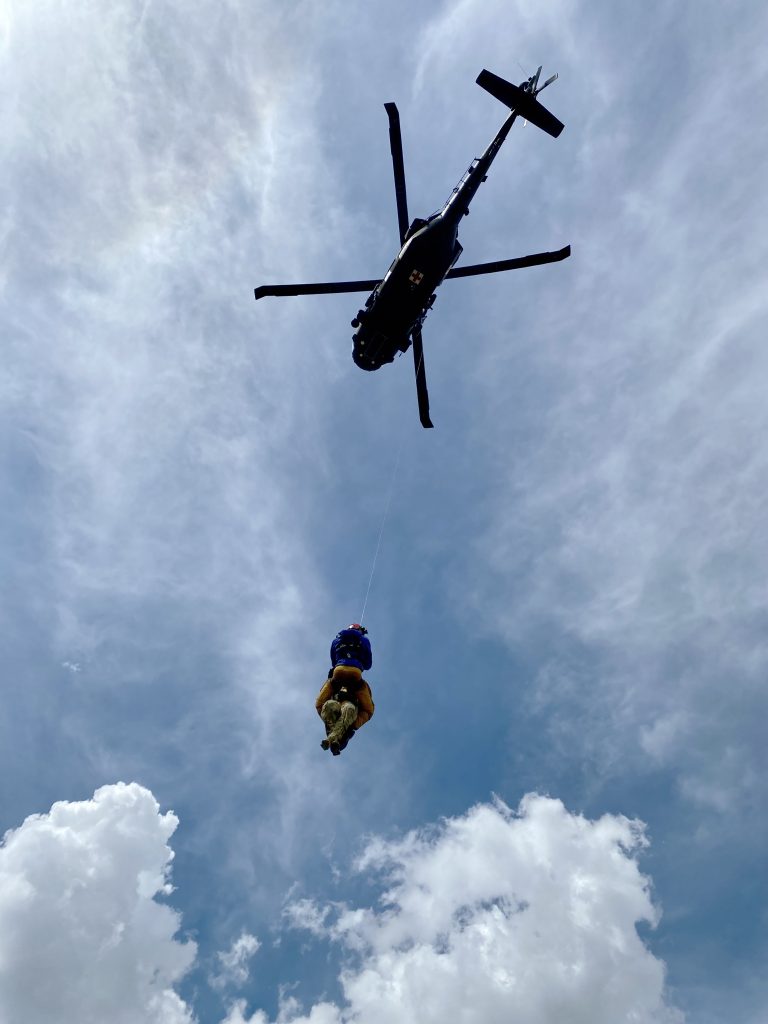
This summer, the Colorado Hoist Rescue Team has responded to hikers stuck on cliffsides, climbers who suffered severe injuries in major falls, people who have been struck by lightning or falling rocks on Colorado’s 14,000-foot peaks, and life-threatening cases of altitude sickness.
In June, the hoist team responded to the summit of Torreys Peak after two hikers were struck by lightning in what has widely been reported as the highest elevation hoist operation — at about 14,200 feet — on record in Colorado.
That month, the team also performed hoist operations to help a father and son who became cliffed-out on a ledge, where a ground rescue would have been dangerous, after losing the trail on Quandary Peak.
And, on June 25, a Black Hawk helicopter hoisted two hikers from a steep cliffside where they became stuck on Capitol Peak, before the same helicopter performed another hoist the same day at Snowmass Lake, rescuing a teenager experiencing a life-threatening case of altitude sickness.
In July, the Colorado Hoist Rescue Team continued to respond to serious backcountry accidents every couple days.
The team performed hoist operations to extract a climber who suffered multiple injuries in a 200-foot fall on Maroon Peak on July 9 and to rescue a hiker who broke their leg in a fall at 13,850 feet on North Maroon Peak on July 13.
When a “microwave-sized rock” tumbled down Little Bear Peak, another 14,000-foot summit, striking a hiker on July 24, the hoist team performed another operation to rescue the unconscious hiker.
The calls for hoist rescues have continued so far in August.
The hoist team helped extract a hiker who sustained injuries in a fall on Snowmass Mountain on Aug. 9, an injured hiker who spent the night on Capitol Peak before being located by rescuers on Aug. 16 and a climber who sustained lower leg injuries in a fall at Rocky Mountain National Park on Aug. 18.
A military-civilian team
The Colorado Army National Guard justifies the use of military helicopters to assist with search and rescue missions, “through the idea that it is incidental to training,” Horney said. Search and rescue missions give the military flight crews the opportunity to practice their skills in real-life situations, he said. The helicopters and crews fly out of the High-altitude Army National Guard Aviation Training Site in Gypsum and Buckley Space Force Base on the Front Range.
But military flight crews aren’t mountaineers who are trained to help hikers and climbers stuck or injured in Colorado’s high peaks, Horney said. That’s where the civilians from the state’s volunteer search and rescue teams come in.
“We figured out that the risk was mitigated best by taking people who have spent their whole life on the mountain doing rescue and then teaching them how to operate in our flight crews,” Horney said. “Versus the reciprocal, which is to try to take our air crew members and try to teach them how to be mountaineers. That is a much longer process and not overly realistic for the vast majority of air crew members.”
Today, four of Colorado’s search and rescue teams — Vail Mountain Rescue Group, Rocky Mountain Rescue Group, Mountain Rescue Aspen and Alpine Rescue Team — each provide eight volunteers who serve as rescue technicians. These experienced rescue volunteers are the people lowered on the hoist into the field to tend to those in need and package them to be lifted back to the helicopter.
Dale Atkins, a more than 50 year volunteer with Alpine Rescue Team, is one of the 32 rescue technicians with the Colorado Hoist Rescue Team.
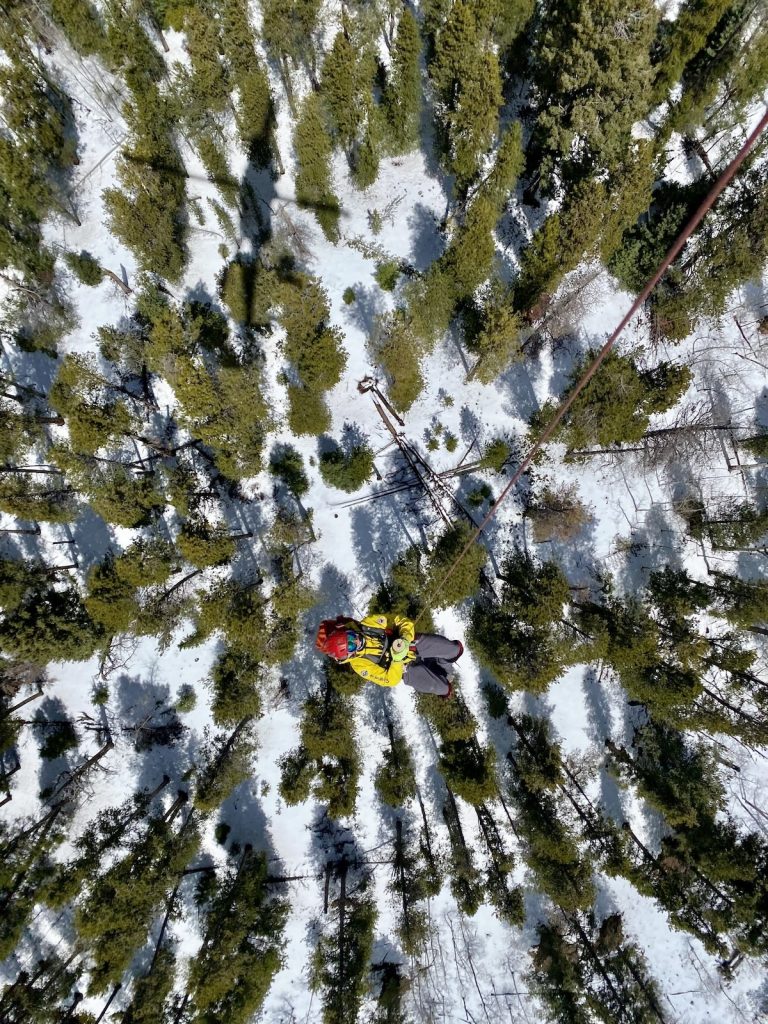
Atkins said that he trains 10 to 12 days a year with the Colorado Army National Guard to be prepared to respond to a helicopter hoist mission. It takes rescue techs more than a year to train before they are deployed on their first hoist mission, he said.
“To me, it has to be like being able to fly. It’s exhilarating,” Atkins said of the experience of dangling from a helicopter on a steel cable that is three-sixteenths of an inch in diameter, slightly thinner than a pencil. “But — and this might sound odd — we train so much, and we have very deliberate processes, so when we’re in the helicopter and we’re being lowered down or raised back up, it’s like a job. It’s a very practiced skill.”
Stranded, injured climber rescued on Capitol Peak
Mountain Rescue Aspen has successfully rescued a climber on Capitol Peak after they were reported “overdue” by the other member of their party.

